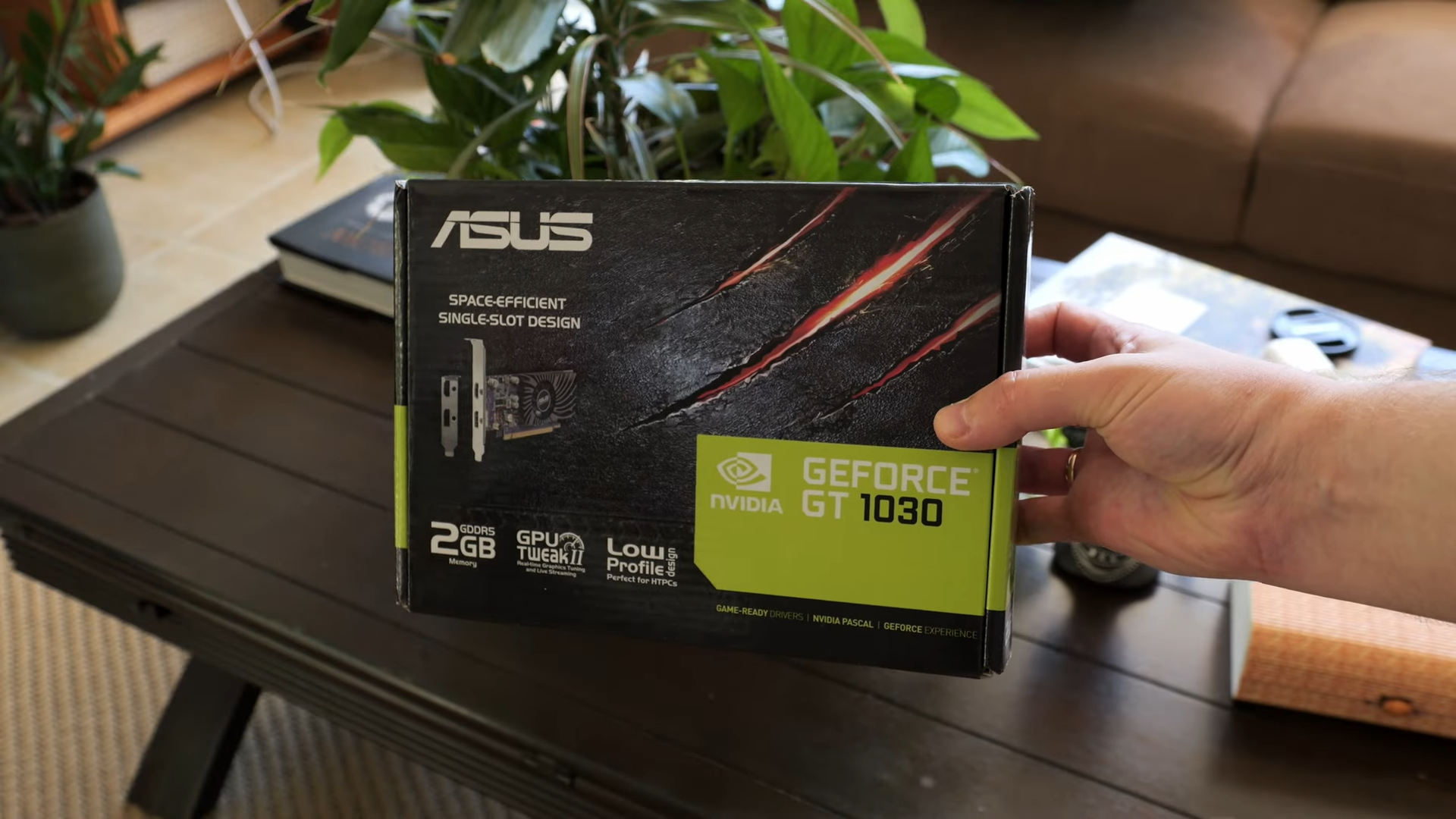Upscaling can't save the world's slowest 'modern' GPU — FSR doubles performance on GT 1030, but titles still barely playable
The GT 1030 can take advantage of FSR upscaling, but it still isn't enough to bring FPS into playable territory in modern AAA titles.

After testing FSR and XeSS upscaling on a GTX 660, YouTuber GCS Hardware has moved on to the GT 1030 (the GDDR5 variant) to see how the slowest DX12-capable GPU copes with upscaling. According to a video they published on the matter, the GT 1030 technically can take advantage of FSR upscaling, but it still isn't enough to boost FPS to playable territory, except on GTA V: Enhanced Edition.
The YouTuber expanded their testing suite with more modern titles, featuring: Kingdom Come Deliverance II, Space Marine II, Alan Wake 2, Cyberpunk 2077, CS 2, and GTA V Enhanced.
The GT 1030 delivered a measly 8 FPS average at native 1080p resolution in Kingdom Come Deliverance II. Enabling FSR 3.1 performance mode significantly boosted performance to 15 FPS average, and moving to a 720p render resolution with the same settings yielded an even greater 21 FPS average. Despite the gains, performance was still well below playable FPS.
Space Marine II was even worse, averaging just 6 FPS on the GT 1030 at 1080p native resolution with low settings. FSR performance mode upscaling more than doubled performance to 13 FPS, but the game was still far from playable.
Alan Wake 2 was the worst-performing game of the bunch, performing in seconds per frame rather than frames per second at native resolution. Native 1080p performance was below 0 FPS average, and FSR ultra performance mode upscaling boosts performance to 3 FPS average.
Cyberpunk 2077 at 1080p native low settings achieved 12 FPS average on the GT 1030. FSR 2.1 ultra performance mode boosted FPS to 21 FPS average, and FSR 3 boosted FPS to 18 FPS average. XeSS had the opposite effect, achieving just 8 FPS average in performance mode.
CS 2, boasted similar issues on the GT 1030 as on the GTX 660, which the YouTuber reviewed two weeks ago. Native performance was decent; 100 FPS average at low settings, but FSR upscaling did not provide any noteworthy performance improvements beyond native rendering.
Get Tom's Hardware's best news and in-depth reviews, straight to your inbox.
GTA V Enhanced ran surprisingly well despite overflowing the GT 1030 GDDR5's 2GB memory capacity. The game ran at 30-40 FPS average while consuming 3 GB of memory (video memory overflows to system RAM when full). FSR 3 performance mode boosted performance to 45 FPS, and FSR 1 performance mode boosted performance to 50 FPS average.
Similar to GCS Hardware's GTX 660 testing, Nvidia's Pascal-based GT 1030 is not powerful enough to play the modern AAA games at playable FPS with upscaling, except for older titles featuring upscaling support.
Still, the GT 1030's performance is a significant improvement from the GTX 660. The Pascal-based GPU was technically capable of performing significantly better with upscaling, in most of the aforementioned titles. The GTX 660, by contrast, did not benefit from upscaling at all in any game GCS Hardware threw at it.
Nvidia's newer Pascal architecture contributes to the GT 1030's ability to take advantage of FSR upscaling better than the GTX 660. FSR is designed to use FP16 calculations to process the necessary data to upscale an image from a lower resolution to a higher resolution with as few artifacts as possible.
Pascal was the first Nvidia architecture to natively support FP16 compute. By contrast, the GTX 660 was based on the Kepler architecture, which only features FP32 and FP64 compute support. FSR has an FP32 fallback mode for these types of GPUs, but using FP32 compute reduces performance.
Follow Tom's Hardware on Google News to get our up-to-date news, analysis, and reviews in your feeds. Make sure to click the Follow button.

Aaron Klotz is a contributing writer for Tom’s Hardware, covering news related to computer hardware such as CPUs, and graphics cards.
-
John Nemesh It was a crap card 5 years ago...no surprises here. Although it probably holds up better than the 5060 8GB will in 5 years...Reply -
deekith ReplyJohn Nemesh said:It was a crap card 5 years ago...no surprises here. Although it probably holds up better than the 5060 8GB will in 5 years.
Or the 9060xt with 8gb as well.. or is it still only cool to hate on Nvidia? My pitchfork is still in tip top shapeJohn Nemesh said:It was a crap card 5 years ago...no surprises here. Although it probably holds up better than the 5060 8GB will in 5 years. -
thestryker Reply
FWIW the 9060 XT handles running out of VRAM better than the 5060 so it's a slightly less bad way to screw buyers over!deekith said:Or the 9060xt with 8gb as well.. or is it still only cool to hate on Nvidia? My pitchfork is still in tip top shape -
John Kiser Why would you expect a low end card from 8 years ago to play modern AAA games when. It was already running the modern AAA games for its time at low settings most of the time? Even doubling performance is maybe going to uplift if time being able to handle about medium settings for the time period it came out in.Reply -
salgado18 Reply
I think testing these things is fun, even if the results are as predictable as this :)John Kiser said:Why would you expect a low end card from 8 years ago to play modern AAA games when. It was already running the modern AAA games for its time at low settings most of the time? Even doubling performance is maybe going to uplift if time being able to handle about medium settings for the time period it came out in. -
bit_user Reply
Yeah, exactly how do you even define "modern GPU"? Nvidia already deprecated it. IMO, if they've already put a product in legacy-support mode, it's no longer modern.User of Computers said:calling pascal modern is criminal lol
On a related note, I fired up an old AMD HD 5450 on Linux, this weekend. It worked right out of the box and even supported full OpenGL. For sure, that thing is slower than the GTX 1030. -
bit_user Reply
The GTX 1030 is a 2 GB card. So, you're saying that 2 GB works better today than 8 GB will work in 5 years? I doubt that.John Nemesh said:It was a crap card 5 years ago...no surprises here. Although it probably holds up better than the 5060 8GB will in 5 years...
VRAM capacity isn't increasing nearly as fast as it used to, and with so many new entry-level cards only shipping with 8 GB, you can bet game developers will be forced to still support them. -
bit_user Reply
It's a dumb youtuber desperate for publicity, being exploited by a lazy and failing tech site that's desperate for clicks.John Kiser said:Why would you expect a low end card from 8 years ago to play modern AAA games when.
You're 100% right. This is pure clickbait. There's nothing to be learned from this, other than quite how badly it ran. I can see more value in that, in the sea of content that is youtube, than I can in the newsfeed of a tech site. It's really not news. Nobody needs to know this.
